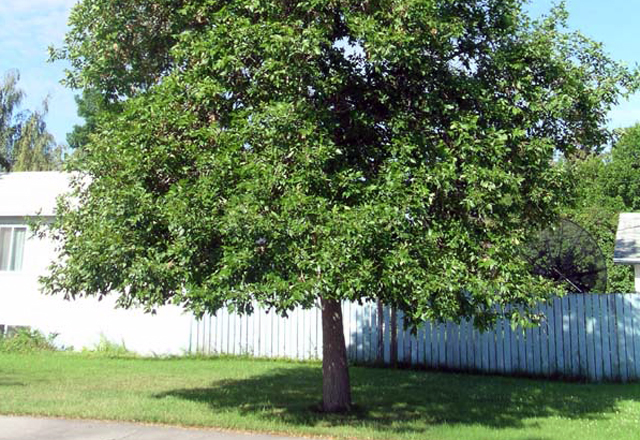Green Ash
 Fraxinus pennsylvanica, or Green ash, grows naturally in bottomlands along streams in the eastern one-half of the United States including most of Kansas. It is a hardy tree, adapted to a wide range of soils and climatic conditions. At maturity, it will reach a height of 35 to 45 feet with a broad, irregular crown. Average annual height growth of 12 to 18 inches can be expected under good management.
Fraxinus pennsylvanica, or Green ash, grows naturally in bottomlands along streams in the eastern one-half of the United States including most of Kansas. It is a hardy tree, adapted to a wide range of soils and climatic conditions. At maturity, it will reach a height of 35 to 45 feet with a broad, irregular crown. Average annual height growth of 12 to 18 inches can be expected under good management.
Leaves, Stems and Fruit
The leaves are compound, 6 to 9 inches long containing 7 to 9 leaflets. They are attached to the twig opposite one another. The leaflets are pointed and have small teeth along the edges. Male and female flowers are borne on separate trees. Fruit is a flat winged seed 1 to 2 inches long and 1/4 inch or less wide. The wing aids in seed dispersal. Bark is ashy gray and furrowed into closed diamond shaped patterns separated by narrow interlacing ridges.
Use
Windbreaks - Because of its moderate size, green ash is versatile in windbreaks. It can be planted as the interior or outside row of a multi-row windbreak. It can also be used for single row field windbreak.
Timber - Green ash is a valuable timber species in Kansas. Its uses include wall paneling, furniture and tool handles.
Firewood - Green ash is recommended in firewood plantations. Its medium growth rate and heat yield provide potential for good firewood production.
Adaptation and Soil
Green ash has adapted statewide and grows best on deep fertile soils along streams. However, once established green ash will persist on dry upland soils.
Spacing
In row spacing in single row and multi-row windbreaks range from 10 to 18 feet. In a firewood or timber planting, the spacing can vary from 6 x 10 feet to 12 x 12 feet.
Culture
One-year-old, bare root seedlings 18 to 24 inches tall are used in tree plantings. Survival and initial growth are very good with proper weed control. Green ash seedlings require direct overhead sunlight.
Pests
Green ash borers and carpenter worms can be a serious problem, especially on dry upland soils.